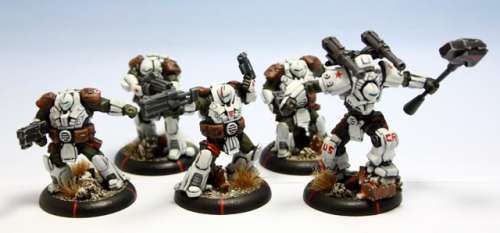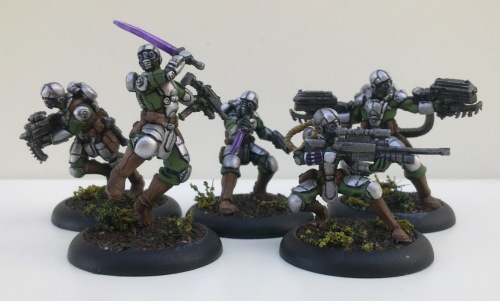For the final post in this series on MERCS, I’ll briefly go over the game system itself. I won’t be going into too much detail, but by then end of this post you should have a good idea of how exactly a game of MERCS actually plays.
Each turn is carried out on a per-model initiative order. Each model, on both sides, roll a d10 at the beginning of every turn to determine each model’s initiative for that turn. Then, from the highest Initiate to the lowest, each model gets a single action. This random initiative really shakes the game up from turn to turn. It can easily happen that some, if not all, of your opponents models can activate twice before your own. Not getting a high enough, or low enough!, initiative on your turn can keep you on your toes and forces your strategy to constantly evolve.
Note that because models only get a single action per turn, this generally means they have to choose to either move or attack each turn. Turns are quick however, so moving into the right position can be just as important an activation as shooting your gun or swinging that Vorpal Phase blade.


For each movement point (MP) a model has (upper right corner of the card) that model can move once. Remember, you use those cards to move. Place the model into the large semicircle cutout and move it to one of the three other cutouts, keeping the model facing the same direction. A model can only turn up to 90° before or after moving with a card. As a model can only see other models in their 180° forward arc and enemy models get various bonuses if attacking your flank or rear, a model’s facing is very important in this game.
On top of the normal movement, each model is allowed one “Snap to cover” per turn. This move that must bring you into base-to-base with cover no more than 1 base width away. It does not count as normal movement and can be done at any point in the turn. This can be used at the end of a move to reach that barricade for cover or can be used to whip around the corner to open fire an enemy scum. This very simple mechanic really offers a lot of options in your strategy and is a key part of the game.
All combat is done with an “FN” system. FN stands for “Firing Number” and is a number between 1-10 that you need to roll equal to or higher to hit with. Each weapon is assigned a base FN value (usually between 6 and 8), but this number is modified depending on the facing of your target as well as if he is in cover or not.
If you hit your target, two things happen:
First, if your weapon’s strength (between 1-4) is equal to or higher than your targets armour value (between 1-4) then they take a single wound (wounds are called “blood” in this game, and most models start with 3). If not then your target loses no health.
Second, your target has to test to see if his armour breaks down. Each unit has their own Armour Failure number that they will need to roll equal to or higher to pass. If not then their armour breaks and which causes their armour value to go down by one as well as immobile until they can fix it. It is an effective strategy to pepper high armour targets with weak weapons knowing you won’t hurt them just to force Armour Break tests. That will lock them down and let you close in for the kill.
As tables are only a couple feet across maximum most guns have an unlimited range. Any weapons that do have range, such as grenades, have a range that is measured in card lengths. Finally, most heavy or full auto weapons use card ‘templates’ to determine which models are hit with their attacks. These templates are just simple shapes made with the cards, such as a T shape made with 2 cards for a heavy machine gun.
There is a short list of other things models can do as their action, but I won’t go into detail. These are things like Overwatch, Suppression, and Bounding.
Originally this game was designed to be played on printed mats instead of 3d terrain. Most people still do use 3d terrain for their games which makes using the cards for movement a little tricky at times. Because of this the designers put two little white lines on the edge of the card so you can still measure movement distance in tight situations. Overall the cards do take a little getting used to, but it a very cool mechanic that you’ll feel comfortable with after a game or two.
And that is it for my MERCs overview series. Feel free to leave any comments or questions you might have in the space below. Make sure you also check out the MERCs Minis website for more info.


